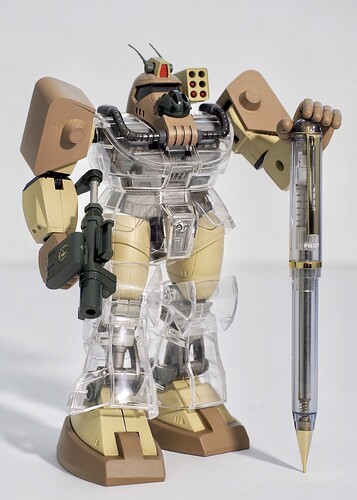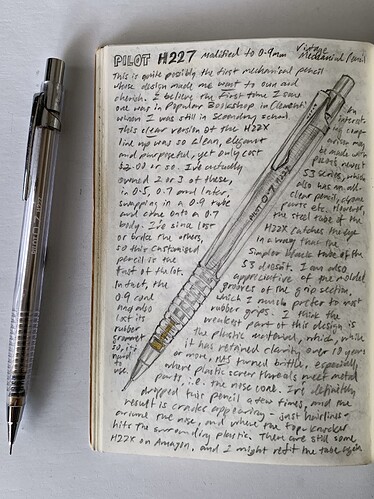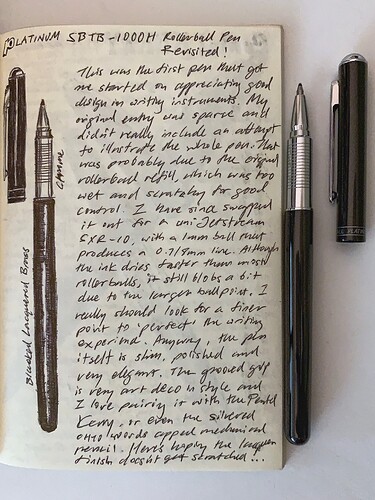I think it’s safe to say that most of us got here via Reddit’s “r/mechanicalpencils” sub, and we were there because our interest in mechanical pencils was above the average. We weren’t content to own a few decent inexpensive mechanical pencils and just move onto other things. No. There was something that tugged at us. Made us take greater notice to this little realm. And then indulge it with expanding collections.
What was it that got you going?
There’s probably a few categories of people who are into mechanical pencils. Some of us work in professions (technical or art) where mechanical pencils are frequently used and we wanted to get the best. And some of us just couldn’t help but be fascinated, even though we don’t use them for our work.
My work tool has been the laptop for the vast majority of life. The keyboard is it. And it even got to the point where my penmanship began to suffer on those infrequent times I’d have to pick up a pen. Eventually it became painfully obvious to me, enough to be a bother. A French girlfriend of mine at the time encouraged me to use a fountain pen to restore my penmanship. I started out with a cheap Stabilo fountain pen and then recovered a long lost Waterman Laureat my sister had given me as a high school graduation present. It looked great in its glossy gunmetal finish, but had a very firm medium nib. I wanted something finer and with a little more give. And that brought me to PILOT. I was just about to buy a Metropolitan, when I came across the Vanishing Point. It blew me away. I had to have one. And so began my fountain pen voyage of discovery. But more so, was my discovery of vintage PILOT. The MYU and pocket sized fountain pens attracted me. And there were so many intriguing designs. Some of them had accompanying ballpoints and mechanical pencils.
When I’d gotten into the PILOT Custom with etched stainless steel bodies, I picked up the matching mechanical pencil. While demure in size, this thing was so well built. I took it apart to find the whole inner mechanism made of metal. Everything about this writing instrument spoke of a design team that was passionate about mechanical pencils. Whereas so many aspects could’ve been cheapened with little impact on performance, the engineers went the other way. This mechanical pencil was built to last a lifetime, if not longer. A far cry from my cheap plastic mechanical pencils used during high school and college.
So I began to comb through writing instrument community forums to see what people were chatting about regarding mechanical pencils. And that’s when I began to realize there was so much more going on. Or more accurately, “had gone on,” back in the 70’s, 80’s, and 90’s. I began to discover brands I’d long thought only made ballpoints, rollerballs, and fountain pens also made mechanical pencils. Like Tombow and Zebra. And while I’d long known of Pentel (I had a couple of Quicker Clickers in high school), I had absolutely no clue that in Japan they were in the top echelon of precision mechanical pencil making since the 1960’s.
Then the lightbulb went off. Ah, yes. Before the computer, there were people in highly technical professions who used mechanical pencils as their prime tools. And so there were different grades of them, all the way up to “top of the line” quality. The kind chief architects, draftsmen, and engineers could afford and would buy for the luxury and status of it. In Japan, the cachet of exclusivity ran especially deep, where certain models would be limited runs and not even exported. These prized writing instruments were like exclusive katanas to the lead wielding samurai.
Finely made, high precision, artistically designed and accented writing instruments. The mechanical pencil endowed with these qualities is something special. Different from a ballpoint, rollerball, or fountain pen. And thanks to the Japanese who revered this kind of writing instrument, paying special tribute by extending those qualities even down to ¥1000 and sometimes ¥500 priced models. It can even come down to little nuances you might miss… then you spot them and know that yes, some product engineer who came up with this design really cared about what they were making.
One other thing about mechanical pencils. You never have to worry about a refill cartridge going extinct. Lead is lead. There will always be lead. ![]()
So that’s how I got here. Your turns! ![]()


